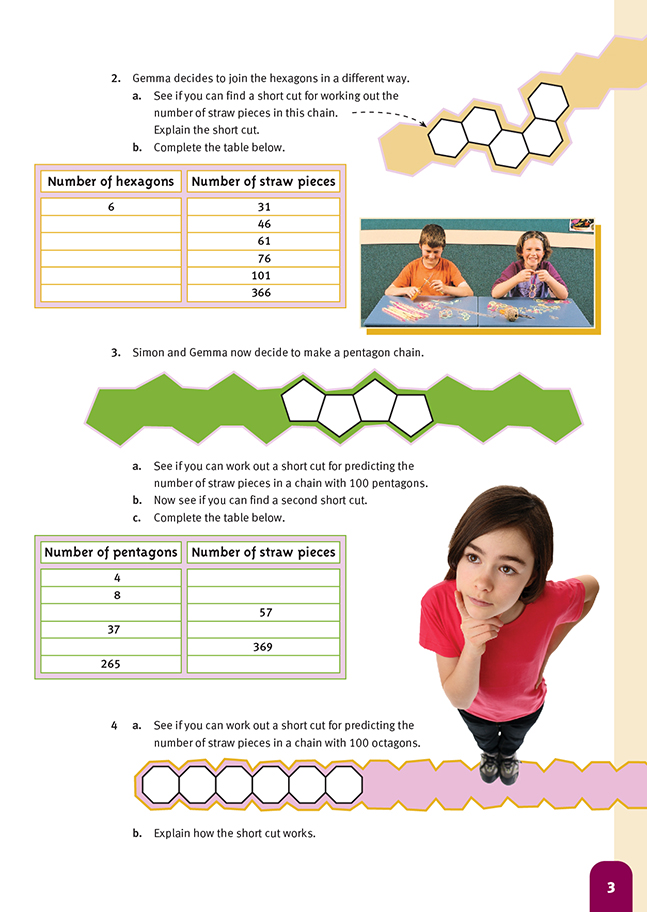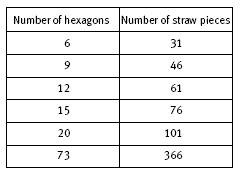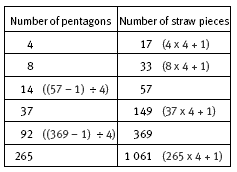This is a level 4 algebra strand activity from the Figure It Out series.
A PDF of the student activity is included.
Click on the image to enlarge it. Click again to close. Download PDF (227 KB)
use a table to complete a number pattern
use a table to find a pattern
FIO, Level 4, Algebra, Book Two, Straw Chains, pages 2-3
This activity asks students to analyse a pattern by breaking it into manageable units so that they can deal with it mathematically.
In question 1, each arrangement of straw pieces is represented by a numerical short cut that can be used to count the number of pieces in the particular chain. For a chain with 100 hexagons, the number of pieces needed is 100 x 5 + 1 = 501, based on Simon’s short cut, and 99 x 5 + 6 = 501, based on Gemma’s short cut.
Simon’s arrangement for a 5-hexagon chain Gemma’s arrangement for a 5-hexagon chain The students should try to explain or write, in their own words, rules based on these short cuts. For Simon’s arrangement, the rule is: number of straw pieces = number of hexagons x 5 + 1. The rule for Gemma’s arrangement is: number of straw pieces = (number of hexagons – 1) x 5 + 6.
These rules can be expressed using algebraic symbols. So, for a chain with x hexagons, the number of pieces,
y, is: y = 5 x x + 1 (for Simon’s rule)
and y = 5 x (x – 1) + 6 (for Gemma’s rule).
5 x x is usually written as 5x, so these rules can be written as y = 5x + 1 (Simon’s rule) and y = 5(x – 1) + 6 (Gemma’s rule).
Although the rules are expressed differently, they are nevertheless equivalent. They produce the same value for y (the number of straw pieces) for particular values of x (the number of hexagons). The students will see this equivalence when they complete the table for question 1c. Algebraically, the two rules are equivalent because y = 5(x – 1) + 6 simplifies to y = 5 x x – 5 x 1 + 6, which is equivalent to y = 5x + 1.
While Gemma’s chain design in question 2 looks different from the earlier designs, the rules for working out the number of pieces needed for such a design with any number of hexagons are the same as the rules for the chains for the earlier designs. That said, the rearrangement of the hexagons may encourage some students to look for new short cuts. One such might be 6 x 5 – 4. In this case, the explanation might be as follows: There are 5 hexagons each requiring 6 pieces, but there are 4 pieces that are counted twice by this method (the pieces that are shared by two adjacent hexagons). So the correct calculation is 6 x 5 – 4.
In general, for an arrangement of this type with x joined hexagons, the number of pieces, y, is y = 6 x x – (x – 1) or y = 6x – (x – 1). It can be shown that 6x – (x – 1) is equivalent to 5x + 1 as per the previous two rules.
In questions 3 and 4, the pentagon and octagon chains have rules for the number of straw pieces that are similar to those for hexagon chains. The following table shows the similarities and differences:
The rules using algebraic symbols are shown below. In each case, y is the number of pieces for chains with x hexagons, x pentagons, or x octagons.
These rules themselves form a pattern that we can use to work out the number of pieces for chains made using any polygon. So, for a chain made with 100-sided polygons, one possible rule is y = 99x + 1. Another is y = 99(x – 1) + 100. Such a chain with, for example, 1 000 polygons, will have 99 x 1 000 + 1 = 99 001
straw pieces (using the first rule).
Although working out data for a 100-sided polygon chain is unlikely to be useful, it is important that the students recognise that the rules presented could be extended in this way if required. The more general a rule is in mathematics, that is, the more situations it covers, the more fundamental or important it is considered to be.
Answers to Activity
1. a. 4 x 5 + 6
b. Possible explanations include:
Simon uses 5 straw pieces to make each hexagon. The sixth piece to complete each hexagon is also used for the first piece in the next hexagon. So the 5 hexagons require 5 x 5 = 25 straw pieces. An additional piece is needed to complete the last
hexagon. The chain with 5 joined hexagons has 5 x 5 + 1 straw pieces.
Gemma uses 5 straw pieces to make the first 4 hexagons. So the first 4 hexagons use 4 x 5 pieces. Then she uses 6 pieces to make the last hexagon. The chain with 5 joined hexagons has 4 x 5 + 6 straw pieces.
c.
.gif)
2. a. One short cut is 4 x 5 + 6 = 26. Although the straw pieces are connected in a different way, the rule from question 1 still applies.
Another short cut is 6 + 4 x 5, with 6 pieces for the first hexagon and 5 for each of the other hexagons.
b.
(The easiest way to find the number of hexagons is to take off the number of straw pieces and divide the answer by 5. For example, (31 – 1) ÷ 5 = 6.)
3. a. One short cut is 100 x 4 + 1. This is based on the short cut 4 x 4 + 1 for 4 joined pentagons and 5 x 4 + 1 for 5 joined pentagons.
b. A second short cut is 99 x 4 + 5. This is based on the short cut 3 x 4 + 5 for 4 joined pentagons and 4 x 4 + 5 for 5 joined pentagons.
c.
4. a. One short cut is 100 x 7 + 1 = 701. Another is 99 x 7 + 8 = 701.
b. The first short cut is based on the short cut 4 x 7 + 1 = 29 for 4 joined octagons and 5 x 7 + 1 = 36 for 5 joined octagons.
The second short cut is based on 3 x 7 + 8 = 29 for 4 joined octagons and 4 x 7 + 8 = 36 for 5 joined octagons.













